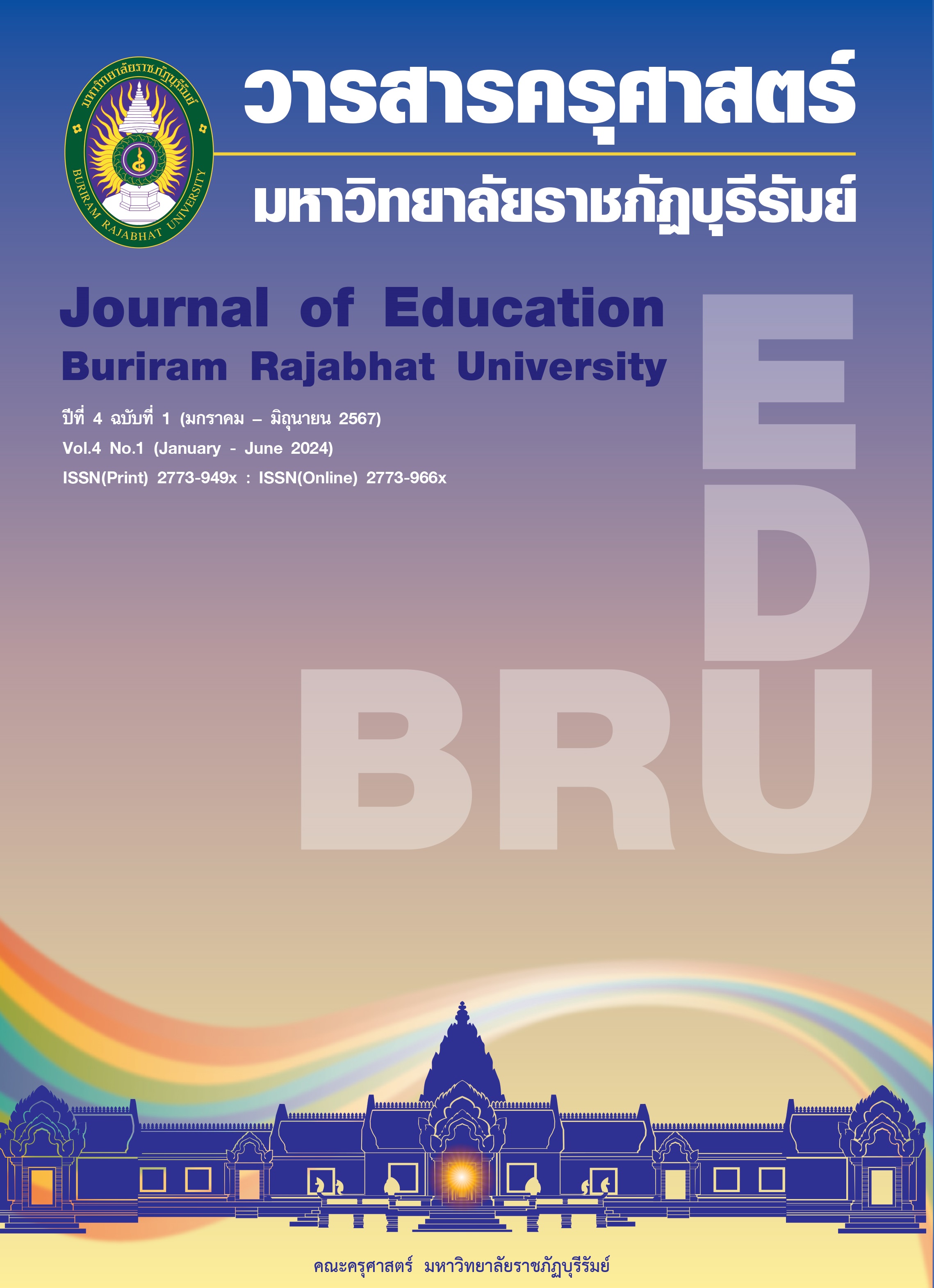Study of Needs from Users’ Experiences Promoting the Mathematical Literacy for Lower Primary School Students
Main Article Content
Abstract
This research aimed to study the needs from the users’ experiences promoting the mathematical literacy for lower primary school students. The target group included 6 mathematic teachers under Basic Education Committee in Mukdaharn Province, 50 lower primary school students, and 5 designers. The research instruments covered the questionnaire form to collect the data from who concerned, the form for collecting the data to determine the interview guidelines and the interview form for the mathematical literacy from the users’ experiences. This research contained the designed thinking including; Phase 1: analysis and survey with Stage 1: problem understanding, Stage 2: problem defining and Stage 3: thinking creation. These action stages became the study support for the needs on the mathematical literacy to design the innovation to promote the mathematical literacy for lower primary school students. The data were collected from the interview form in 5 dimensions, composing of roles, feeling emotion, perceptions, attitudes and behaviors. The data analysis with the qualitative data was analyzed by the content analysis. The research results exposed that: 1) the needs of teachers, students and designers became related the mathematical literacy promotion, concrete media correlated to the content and school contexts, 2) the users’ experiences in 5 mathematical literacy dimensions implied that: 2.1) the role dimension was mostly learning and teaching management based on the self-aptitude, emphasizing teaching following the learning management plans and school contexts, 2.2) the feeling emotion dimension showed that this teacher group felt the students were rather poor in the background having to adapt the contents and students themselves, 2.3) the perception dimension illustrated that teachers perceived from the students’ doing homework and test results from those students who were not rather poor and without the enthusiasm in those their stories, 2.4) the attitude dimension showed that the students did not like mathematics, enabling the lack of attention, and 2.5) the behavioral dimension implied that teachers and students’ participated in promoting the mathematical literacy, comprising being pleased to take the innovation derived from this research to use in their own learning and teaching management in order to promote the mathematical literacy.
Downloads
Article Details
บทความที่ได้รับการตีพิมพ์ลิขสิทธิ์เป็นของวารสารครุศาสตร์ มหาวิทยาลัยราชภัฏบุรีรัมย์ อนุญาตให้เผยแพร่เพื่อการศึกษาและวิจัย ในวงการวิชาการ ไม่อนุญาตการใช้ประโยชน์เพื่อการแสวงหากำไร
ข้อความที่ปรากฏในบทความเป็นความคิดเห็นส่วนตัวของผู้แต่ง ซึ่งวารสารครุศาสตร์ มหาวิทยาลัยราชภัฏบุรีรัมย์ ได้ประเมินคุณภาพตามหลักวิชาการ ผลกระทบอันเกิดจากความคิดเห็นของผู้แต่งเป็นความรับผิดชอบของผู้แต่งเอง
References
ชรินรัตน์ ด้วงธรรม, และ วนินทร พูนไพบูลย์พิพัฒน์. 2565. “การพัฒนาความฉลาดรู้ด้านคณิตศาสตร์ด้วย
การจัดการเรียนรู้ออนไลน์ ตามกระบวนการคิดให้เป็นคณิตศาสตร์ เรื่อง ความน่าจะเป็นของนักเรียนชั้นมัธยมศึกษาปีที่ 5”. Journal of Roi Kaensarn Academi, 7(11), 372–89.
มาริษา นามกุล, และ ประกฤติยา ทักษิโณ. 2566. “การวิเคราะห์ปัจจัยด้านความเหลื่อมล้ำทางการศึกษาที่ส่งผลต่อความฉลาดรู้คณิตศาสตร์ภายใต้โปรแกรมประเมินสมรรถนะนักเรียนมาตรฐานสากล (PI-SA)”. Journal of Educational Measurement Mahasarakham University, 29(1), 148–60.
สุทธารัตน์ บุญเลิศ, และ ธัญญา กาศรุณ. 2566. “การพัฒนางานทางคณิตศาสตร์ที่สอดคล้องกับกรอบการประเมินของ PISA เพื่อส่งเสริมความฉลาดรู้ด้านคณิตศาสตร์ของนักเรียน”. Journal of Roi Kaen-Sarn Academi, 8(6), 381–92.
สุวิมล ว่องวาณิช. (2563). การวิจัยออกแบบทางการศึกษา. กรุงเทพฯ: จุฬาลงกรณ์มหาวิทยาลัย.
สำนักงานคณะกรรมการการศึกษาขั้นพื้นฐาน. (2560). Office of the Basic Education Commission [ออนไลน์]. สืบค้นเมื่อ 25 เมษายน 2566, จาก https://academic.obec.go.th/images/doc-ument/1572317446_d_1
อภิสิทธิ์ ไล่ศัตรูไกล. (2557). SERVICE DESIGN WORKBOOK คู่มือการออกแบบบริการ. กรุงเทพฯ: ศูนย์สร้างสรรค์งานออกแบบ (TCDC)
Genc, M. & Erbas, A. K. (2019). Secondary Mathematics Teachers' Conceptions Of Mathemat-ical Literacy. International Journal of Education in Mathematics, Science and Technology, 7(3), 222-237.
Haara, F. O., Bolstad, O. H., & Jenssen, E. S. (2017). Research on Mathematical Literacy in Schools--Aim, Approach and Attention. European Journal of Science and Mathe-matics Education, 5(3), 285-313.
Hardianti, S., & Zulkardi, Z. (2019, October). Students’ Mathematical Literacy Abilities in Solving PISA Type Math Problem with LRT Context. In Journal of Physics: Confer-ence Series, 1315(1), 012016.
Hassenzahl, M., & Tractinsky, N. (2006). User Experience-A Research Agenda. Behaviour &
InforMation Technology, 25(2), 91-97.
Holenstein, M., Bruckmaier, G., & Grob, A. (2021). Transfer Effects of Mathematical Literacy: An Integrative Longitudinal Study. European Journal of Psychology of Education, 36(3), 799-825.
Kolb, D. A. (2014). Experiential Learning: Experience As The Source of Learning and Develop-ment, FT Press.
Lazuardi, M. L. & Sukoco, I. (2019). Design Thinking David Kelley & Tim Brown: Otak Dibalik Penciptaan Aplikasi Gojek. Organum. Jurnal Saintifik Manajemen Dan Akuntansi, 2(1), 1-11.
Mandasari, N. (2021). Problem-Based Learning Model to Improve Mathematical Reasoning Ability. In Journal of Physics: Conference Series. 1731(1), 012041).
OECD. (2018). PISA 2022 Mathematics Framework (Draft). Online. Retrieved August 4, 2021. From : Https://Pisa2022-Maths.Oecd.Org
Pradana, A. R., & Idris, M. (2021). Implements’ User Experience Pada Perancangan User Inter-face Mobile E-Learning Dengan Pendekatan Design Thinking. Automata, 2(2).
Sagita, Laela, Ratu Ilma Indra Putri, Zulkardi, และ Rully Charitas Indra Prahmana. 2565. “Promising Research Studies Between Mathematics Literacy And Financial Literacy Through Project-Based Learning”. Journal on Mathematics Education, 13(4),753–72.
Syafitri, R., Putra, Z. H., & Noviana, E. (2020). Fifth Grade Students’ Logical Thinking In Mathematics. Journal of Teaching and Learning In Elementary Education (Jtlee), 3(2), 157-167.
Utari, T. S. G., Kartasasmita, B. G., & Julika, C. (2019). The Application Of Situation-Based Learning Strategy To Improve Literacy Skills, Mathematical Problem-Solving Ability And Mathematical Self-Efficacy At Senior High School Students. International Jour-nal of Innovation, Creativity And Change, 6(1), 89-102.

